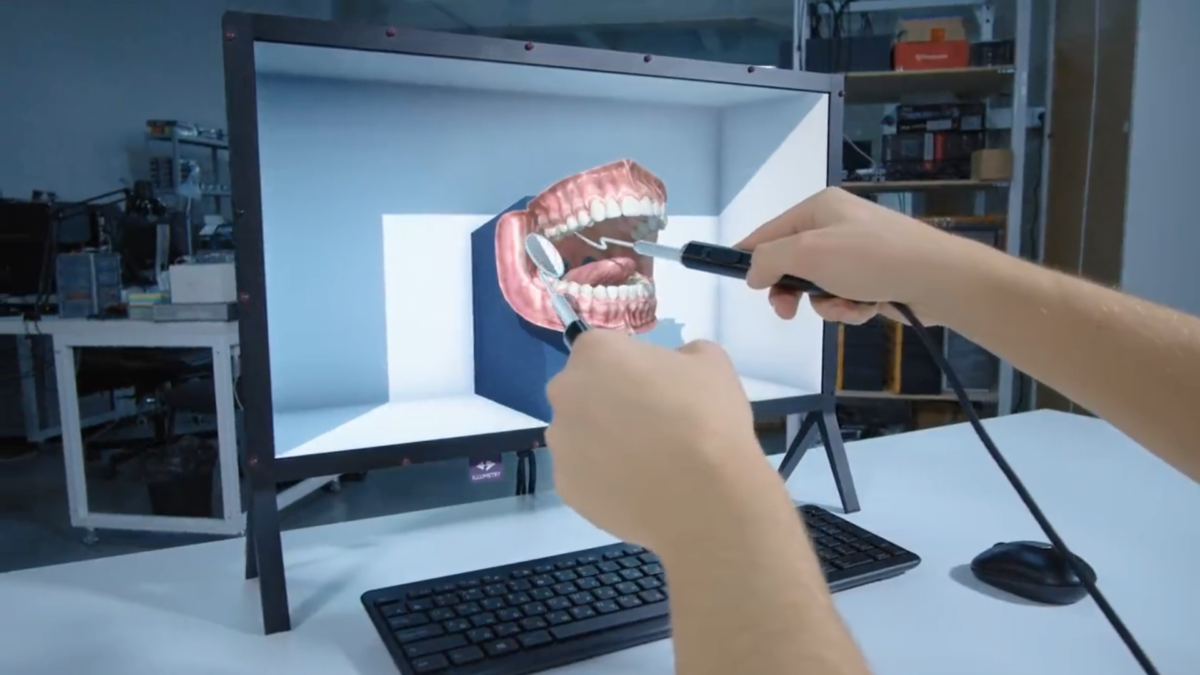The Illumetry IO XR display does not require VR headset for 3D

The "Illumetry IO" XR display is designed to enable mixed reality on the monitor for industry, healthcare, and spatial training.
Cyprus-based Antilatency has so far focused on developing the smallest possible tracking systems for virtual reality and related fields. A new product takes advantage of advances in the field to create a holographic LC display with spatial rendering. The first model in the new range is the Illumetry IO which offers 1080p resolution on a 24-inch screen.
Users sit in front of the screen as usual. They see 3D objects correctly displayed in perspective, even if they lean to the side to view them from different angles - no bulky headset required. However, the display requires a slim headset with active shutters and lateral tracking units.
Mixed Reality in front of the monitor
The technology is similar to the 3D shutter glasses introduced for supported PC games ten years ago. However, two tracking modules at the edges of the glasses ensure that objects appear authentically even from oblique viewing angles.
See how true to life the teeth look 😳 #augmentedreality #extendedreality #xr #HolographicDisplay #AR pic.twitter.com/rlugsBmvGH
— Illumetry (@illumetry) March 1, 2023
This means that a dentist in a training application can examine the side and back corners of a virtually reconstructed mouth in the correct perspective, similar to virtual reality. The description even promises that this is possible "from any angle".
Antilatency calls its technical implementation "MotionParallax3D". The "Alt" modules on the edges of the headset play an important role. According to the manufacturer, these are the world's smallest position trackers, each measuring under a cubic inch and weighing practically nothing.
Each tracker contains both an inertial measurement unit (200 hertz) and an optical sensor that detects an invisible infrared pattern on the edge of the screen. Motion prediction is designed to ensure that incipient motion is detected and implemented before an image is rendered. This avoids perceptible latency, according to the manufacturer.
An "Alt" tracker is also integrated into the included stylus. It serves either as a 3D cursor or as the basis for attachments such as surgical tools that can be used to move content in training applications. Depending on the application, customers can add multiple styli or other tracker objects.
Holographic monitor for business and training
Development tools support both Unity and Unreal Engine. Native programming interfaces for C# and C++ are also available to integrate the display with other 3D engines. Supported operating systems include Linux, Windows, and Android.
With the new display, Antilatency aims to take the public perception of mixed reality from futuristic entertainment niche to everyday tool. In addition to training applications and business simulations, the company says it is also interested in being used by 3D artists or as a teaching medium to create a "wow factor" in students.
The maximum refresh rate is 120 Hz, and the response time is 5 milliseconds. Larger displays are also planned. According to Antilatency, the price is in the range of high-end VR headsets. Interested distributors or developers can contact the company via the official website.
Those who don't want to wear any kind of headset when viewing 3D content should take a look at Brelyon's curved light field monitors, Looking Glass' 65-inch holo display, or Sony's "Spatial Reality Systems" with eye tracking. They also promise a convincing spatial impression - in these cases completely without a special headset.
Note: Links to online stores in articles can be so-called affiliate links. If you buy through this link, MIXED receives a commission from the provider. For you the price does not change.